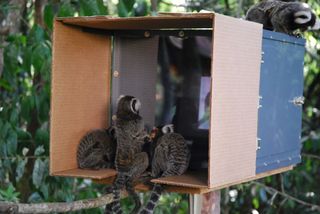Wild Monkeys Learn to Puzzle Out Banana Video

The wild marmosets living in the Brazilian forest have never seen a television show and certainly have never watched a movie in their jungle homes, until now. When scientists showed the newbies a short flick of a marmoset stranger opening a box to get a banana slice, they were likely to copy what they saw in the video and open the box themselves, a new study finds.
The study provides a glimpse into how these new world monkeys learn from each other in the wild, said the study's lead researcher Tina Gunhold, a cognitive biologist at the University of Vienna.
"It was actually the first time where we used such a challenging task," Gunhold said. "Normally they're quite easy. The more difficult the task is, the more important social learning becomes." [See Marmosets Watching a Video in the Brazilian Forest (Video)]
Marmosets are social by nature. They live in small family groups typically ranging from five to 15 monkeys, and they live and forage in a defined home range. But marmosets are territorial, and may fight each other if another group encroaches on their home range.
Within the group, however, marmosets are social creatures. The whole group will help raise a new infant. This social learning can help young marmosets understand what foods to eat and how to recognize predators, such as snakes, birds and wildcats.
Learning from watching a video, however, is another lesson entirely. Marmosets, as well as other monkeys in captivity, can learn from watching their peers in videos, research suggests. But Gunhold and her colleagues wanted to see whether common marmosets (Callithrix jacchus) living in the wild could also learn from the silver screen.
Gunhold's group designed a clear box that could hold a treat, such as a tasty banana.
Sign up for the Live Science daily newsletter now
Get the world’s most fascinating discoveries delivered straight to your inbox.
"They just love banana," Gunhold told Live Science. "They would do anything for it."
The marmosets could reach the fruit either by opening a drawer or by pushing a lid upward — a difficult feat, she said. But she gave them some help: The research team showed videos and images of unfamiliar marmosets opening the box.
The researchers took a miniature movie theater composed of a laptop screen in a box to the home ranges of 12 family groups. In all, 108 marmosets participated.
Six of the groups simply watched a still image of a female marmoset opening the drawer or a male marmoset pushing up the box's lid. The other six groups saw a 5-minute video of the marmosets doing the same thing.
The video presented a double whammy — not only was the marmoset in the film a stranger, but the video itself was likely confusing, as the marmosets had never seen one before, said Lydia Hopper, a research scientist at Lincoln Park Zoo in Chicago, who was not involved with the study.
"Even young human children take time and need experience with videos and 2D images to learn how to interpret them and how to understand them," Hopper said.
However, the marmosets that watched the videos tended to interact more with the box and successfully open it to win the banana prize compared with marmosets that just saw the images. In all, just 13 percent of the marmosets — 11 marmosets in the video group and one in the still-image group — managed to open the box. Those that watched the video tended to open it in the same way that the monkey in the video did, the study found. [In Photos: Wild Marmosets Watch Videos of Banana Puzzle]

"This emphasizes the importance of them receiving the video demonstration," Hopper said, adding that it was possible that "those that were successful really did learn from the video, because it really was a hard task."
The one marmoset that saw the still image and managed to accomplish the task on his own "was just simply very excited about the box," Gunhold said. "He was trying on his own and interacting with it, and through trial and error he figured out how to open the drawer."
Younger monkeys tended to spend more time near the box than older monkeys did, likely because of their increased curiosity, Gunhold added. The sex of the marmosets in the video and still image had no bearing on the results.
The scientists aren't sure what the monkeys watching the video were thinking, but say it seems unlikely they considered a real monkey was living in the screen. "If they really thought this was an unknown individual, at least we would have seen more agonistic or fearful reactions," Gunhold said. "[But] they were not scared of the video."
The study paves the way for new research on cognition in wild marmosets, Hopper said. For instance, do marmosets copy any monkey, or do they tend to selectively copy other individuals that are dominant or excel at a certain task? "We're looking at how flexible their learning is now," Hopper said.
The study was published online today (Sept. 2) in the journal Biology Letters.
Follow Laura Geggel on Twitter @LauraGeggel and Google+. Follow Live Science @livescience, Facebook & Google+. Original article on Live Science.

Laura is the archaeology and Life's Little Mysteries editor at Live Science. She also reports on general science, including paleontology. Her work has appeared in The New York Times, Scholastic, Popular Science and Spectrum, a site on autism research. She has won multiple awards from the Society of Professional Journalists and the Washington Newspaper Publishers Association for her reporting at a weekly newspaper near Seattle. Laura holds a bachelor's degree in English literature and psychology from Washington University in St. Louis and a master's degree in science writing from NYU.
